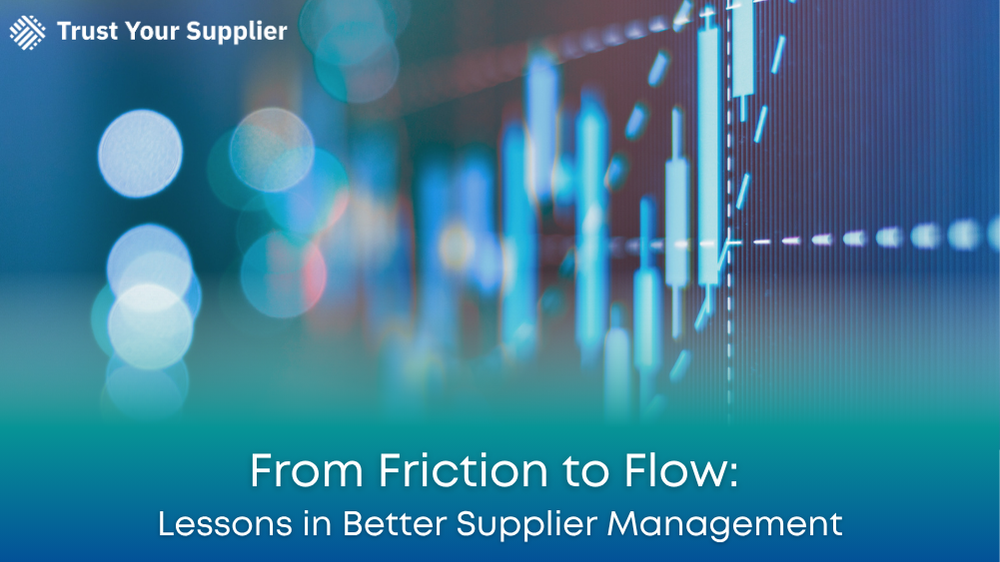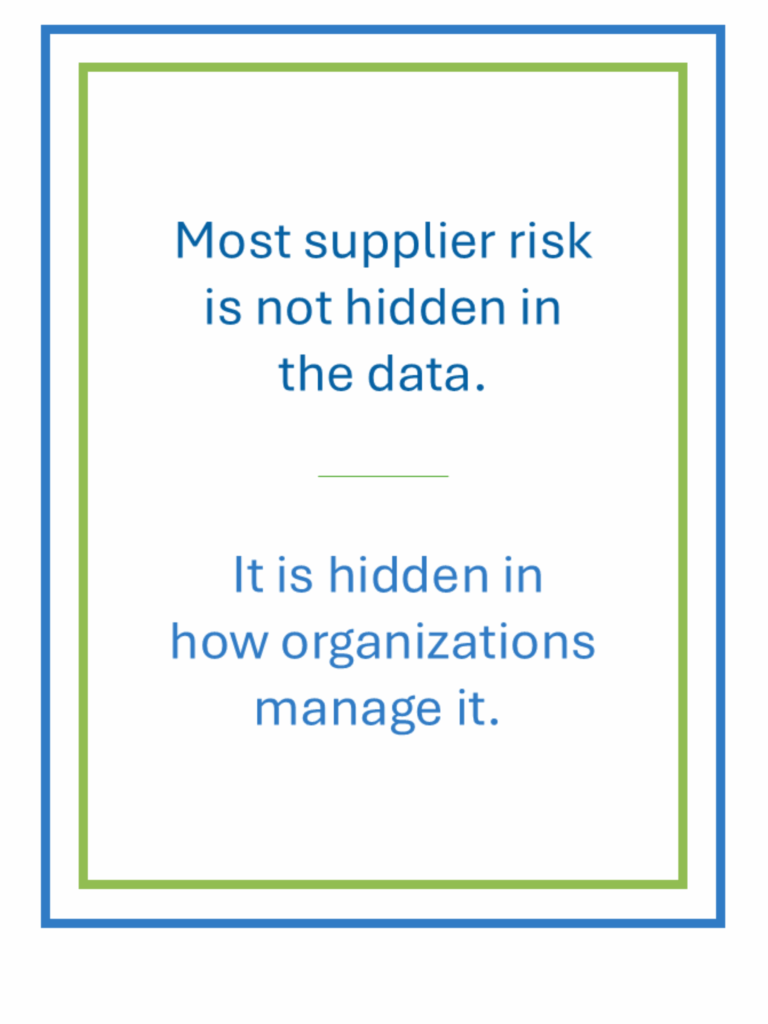From Friction to Flow: Lessons in Better Supplier Data Management
What TYS has Learned from Analyzing Thousands of Supplier Profiles

Procurement teams rarely fail because they lack supplier data. Ultimately, they fail because they cannot trust or use it effectively. At Trust Your Supplier (TYS), we review and analyze supplier data across industries. We assess the information suppliers provide, and what’s missing. We also study how organizations collect, govern, and share that data, and how effectively they use it across procurement, finance, legal, and compliance teams.
When you analyze this volume of data, patterns emerge. You begin to recognize what strong supplier data governance looks like and what happens when it breaks down.
Below, we share some of the most common challenges and opportunities we’ve observed. Taken together these insights highlight that managing supplier information is about more than documents or compliance checklists. Instead, it’s about building trust, visibility, and accountability into every supplier relationship.
1️⃣ Most supplier data isn’t wrong — it’s incomplete, outdated, or disconnected.
The real problem isn’t bad data. It’s fragmented ownership.
Observation:
Few suppliers intentionally provide inaccurate data. More often, their profiles are incomplete — missing tax IDs, expired certificates, inconsistent questionnaire responses, or incomplete ownership details.
Why this happens:
Data often resides in different departments within the Supplier’s shop. For example, HR maintains executive details. Finance handles bank accounts. Operations manages certifications, while Legal tracks insurance coverage. Even when one supplier resource coordinates the response, data is often emailed piecemeal to different contacts in the buyer’s organization. Consequently, errors and omissions are inevitable.
Why it matters:
Every missing field creates friction. Procurement teams chase updates from suppliers and internal stakeholders. Discrepancies trigger long email chains and delays. Suppliers wait for approvals, and onboarding stalls, draining both time and trust.
Better practice:
- Set expectations early. Tell suppliers what information is required upfront to prevent unnecessary back-and-forth.
- Centralize supplier data. Create one source of truth that can be used across departments and business units.
- Automate validation. Use verified third-party sources to pre-validate and refresh data continuously, so supplier information stays accurate and dynamic.
2️⃣ The “Ultimate Parent Company” often tells a bigger story.
Look beyond the name on the RFP.
Observation:
It’s increasingly common for organizations to receive RFP bids from seemingly different companies that share the same ultimate parent. Conversely, a supplier that appears under-resourced may be part of a much larger, globally distributed enterprise.
Why this happens:
Corporate ownership structures are complex, shaped by mergers, acquisitions, and holding companies. Without consistent mapping of parent entities, procurement teams may overlook these relationships.
Why it matters:
Hidden ownership can undermine supplier diversity, competitive sourcing, or ethical procurement goals. Furthermore, the size and location of a parent company can also change the risk profile and compliance requirements of a supplier. Without transparency, teams may dismiss capable suppliers or inadvertently concentrate spend.
Better practice:
- Verify ownership continuously. Cross-check supplier data with trusted third-party databases to maintain visibility and integrity.
- Monitor for changes. Use continuous monitoring to detect shifts in ownership or control that could affect risk or compliance.
- Evaluate the bigger picture. Consider how parent-company relationships may impact diversity, competition, or sourcing strategies.
3️⃣ ESG and human rights are no longer optional.
ESG transparency has become essential to supplier trust.
Observation:
Disclosures once considered “nice to have”, such as human rights policies, modern slavery statements, and environmental impact data, are now core components of supplier due diligence. Missing ESG data often hides early warning signs.
Why this happens:
New and evolving regulations across multiple regions now require companies to trace their supply chains beyond Tier 1. Much of this data remains fragmented or self-reported, and many suppliers are still adapting to the pace of change.
Why it matters:
Incomplete or unverified ESG information exposes organizations to compliance penalties, reputational risk, and ethical blind spots. Missing transparency can mask deeper risks in labor or environmental practices.
Better practice:
- Integrate ESG data into supplier profiles. Include environmental, social, and governance disclosures as a standard part of supplier records.
- Validate information externally. Use reliable third-party providers to verify ESG claims and fill data gaps.
- Stay aligned with global standards. Adapt due diligence processes to meet evolving regional and international regulations.
Procurement leaders must now combine cost efficiency with corporate responsibility, making ESG diligence an integral part of supplier management.
4️⃣ When multiple functions “check the boxes,” supplier data management gets muddled.
Silos slow progress and increase risk.
Observation:
Even when supplier data exists, organizations often struggle to turn it into coordinated action. Complete supplier information is scattered across functions and stored in separate departmental systems or buried in email. Duplicated due diligence checklists and inconsistent requirements create confusion and frustration for suppliers.
Why this happens:
Each function manages its own process. Procurement and Legal may request the same information (e.g., sub-supplier lists) but for different purposes. Without a shared workflow, departments unknowingly duplicate efforts or overlook critical risks.
Why it matters:
Siloed data and redundant processes reduce transparency, slow onboarding, and increase risk. Suppliers perceive the buyer as disorganized, while internal teams waste time reconciling conflicting records. Critical red flags can easily slip through the cracks.

Better practice:
Adopt a cross-functional supplier management model that:
- Create a shared supplier management model. Establish one accessible source of supplier information for all relevant teams.
- Apply role-based access. Protect sensitive information while ensuring transparency across departments.
- Use shared workflows. Coordinate tasks and approvals so that Procurement, Legal, and Compliance work from the same data in real time.
Ultimately, this unified approach builds efficiency, strengthens collaboration, and enhances risk management.
Final Thoughts
Across our experience reviewing supplier data profiles, one truth stands out: most supplier risk is not hidden in the data itself. It is hidden in how organizations manage that data.
Time and again, we have seen that unified platforms and shared information create stronger collaboration between Procurement, Finance, Legal, and Compliance teams. Verified data and automated monitoring from trusted external sources increase accuracy and reduce risk. When supplier data sits in silos, even strong suppliers can appear risky, and real risks can go unnoticed.
Supplier data management is not just an administrative process. Rather, it is a foundation for trust, visibility, and accountability across your entire supply chain.
These lessons reveal that supplier data is more than information to collect. It is a relationship to manage. When buyers and suppliers share ownership of that process, transparency improves, onboarding accelerates, and trust deepens.
Trust Your Supplier brings these best practices to life.
With TYS Essentials, procurement teams can:
- Connect with qualified suppliers
- Collaborate across departments
- Verify data independently and continuously
- Accelerate onboarding
- Strengthen compliance and reduce supply chain risk
Build a supplier data foundation that drives confidence and performance.
👉 Explore our solutions to learn more or request a demo today.
